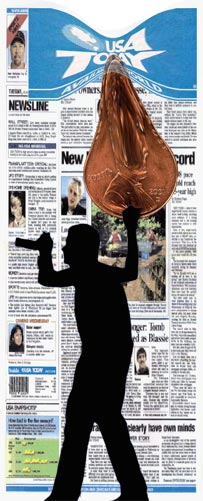The Business of Colorspace
 What colorspace to deliver in ?
What colorspace to deliver in ?
Every photographer has an opinion, and there are about 30 experts for every different colorspace. Some swear by sRGB, others swear by ColorMatch, still others insist on Adobe 1998, and then there are the clients who insist on CMYK, and then when you ask them what profile, they haven no idea what you're talking about.
Realizing, however, that it is now your responsibility to handle colorspace issues means you are at step 1. This also often means that the client will lay the blame on you when the image doesn't look the way it should.
First things first through - what colorspace is your camera capturing images in when it's capturing raw images? Answer: It's not. Capturing images in raw, means that no colorspace is defined. The colorspace is chosen and assigned by the raw conversion software, like Camera Raw, Capture One, and so on. The colorspace set in the camera when you're shooting raw is just a tag, the raw data is not diminished by your choice. The raw data from the sensor is just that, raw light values coming from the sensor.
ProPhotoRGB has colors in it that are not in Adobe 1998. Adobe 1998 has colors in it that are not in sRGB. When you are making your conversions in your raw converter, and making your general corrections there as well, having the widest gamut will serve you best to make your corrections and adjustments. However, can the client handle that? You need to know, or risk a client who feels you underserved them.
So, what clients get what colorspace?
Well, many photographers point to ColorMatch as the one which most closely resembles CMYK, and when your work is going to a CMYK printing output, what you deliver, when delivered in the ColorMatch colorspace, will yield results as close as possible to what the final output will look like.
If your client is outputting to a premium grade press, with six color output, the images will appear best in a broader gamut colorspace like ProPhotoRGB, or BruceRGB. You'll know these clients though. They are spending a lot of money on their output, and they will make you aware of details in a very specific fashion, talking about setting your white point to something like 246, and your black point to 11, and they will be asking for uncompressed TIFs, at a very specific DPI, which will NEVER be something as generic as "300". The likelihood is that most of you will encounter only one of these clients a year. And these are the clients, more often than not, that are not bickering with you over post production charges, and you were likely paid a premium creative fee and fairly priced licensing.
If you are expecting your client to send your files to a Fuji Frontier, Noritsu, or other one-hour-type lab, your safest bet is going to be sRGB. Sending these clients file in a wider colorspace like Adobe 1998 will mean, when they send it to the lab straight from your CD, almost always the files will come out looking milky.
If your client is going to have your images on the web, again, delivering the final files to them as sRGB is going to be safest. They (or their web team) will most likely not convert it themselves.
For about 80% of my clients, they do not know what colorspace is, let alone, what colorspace they want. For these, after I optimize the files in my editing suite, I convert them to sRGB, and burn them to a CD as JPEG's.
For clients who INSIST on a CMYK colorspace, but won't tell me which one, or provide a profile to convert to, it's SWOP v2. Period. However, I ALSO provide them with a file in ColorMatch, and advise them:
"Enclosed is the final file, converted to CMYK, as you have requested. Because we did not recieve a specific colorspace or device profile specification, we have chosen a standardized CMYK colorspace, SWOP v2. We have also provided the same file in an RGB colorspace called ColorMatch. This colorspace most closely resembles CMYK, but has not been converted. If you, or your printer, has a color profile for the printer your are outputting on, we recommend a conversion from that ColorMatch RGB file to your device-specific CMYK profile for optimum results."This notice not only provides our clients with the maximum amount of information and flexibility, but also conveys to them the level of attention to detail we give to every project and to the clients needs.
You may have a difference of opinion about the specifics of the above, but what should not be in dispute is your very real obligation to be responsible for the proper colorspace for your client. Understanding colorspace, and how to best serve your clients through it, is but one reason why not only do we never deliver raw files, we have solid justification for our post-production charges.
Please post your comments by clicking the link below. If you've got questions, please pose them in our Photo Business Forum Flickr Group Discussion Threads.
 My office opens at 10am, (but I do take calls if they come in earlier than that), and stays open until 6pm. I frequently stay up late to do paperwork, and every once in awhile I get a call from the west coast at 9pm where the caller is surprised to reach me, saying "oh, I was expecting to get voicemail...".
My office opens at 10am, (but I do take calls if they come in earlier than that), and stays open until 6pm. I frequently stay up late to do paperwork, and every once in awhile I get a call from the west coast at 9pm where the caller is surprised to reach me, saying "oh, I was expecting to get voicemail...".  As USA Today's freelance photographers toil away, chasing the newly minted boys of summer, look for an angle during the NCAA playoffs, or carefully lighting the latest celebrity for the front page of Life, the penny-pinching tighwad bean counters have foisted upon the desk editors of the "Nation's Newspaper" the latest rights grab that has riled up many a photographer. I've had several requests -- "John, you gotta comment on this...".
As USA Today's freelance photographers toil away, chasing the newly minted boys of summer, look for an angle during the NCAA playoffs, or carefully lighting the latest celebrity for the front page of Life, the penny-pinching tighwad bean counters have foisted upon the desk editors of the "Nation's Newspaper" the latest rights grab that has riled up many a photographer. I've had several requests -- "John, you gotta comment on this...". Everyone's got an angle to the Anna Nicole Smith story, and I mean everyone. One of the "trashy" blogs I read to keep up instead of buying the National Enquirier during checkout is TMZ.com.
Everyone's got an angle to the Anna Nicole Smith story, and I mean everyone. One of the "trashy" blogs I read to keep up instead of buying the National Enquirier during checkout is TMZ.com. 